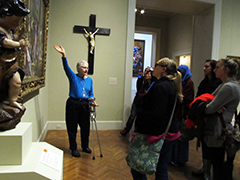Students who experienced homelessness or high mobility had chronically low levels of reading and math achievement compared to their peers — gaps that either stayed the same or worsened as students approached high school, according to a longitudinal study conducted through a partnership of the University and Minneapolis Public Schools.
The study, published Oct. 30 in the journal Child Development, found that homeless and highly mobile (HHM) students did not catch up to their peers during a six-year period.
Furthermore, HHM students showed lower levels of achievement, and slower growth in math achievement, during years in which they experienced homelessness and high mobility compared to their own achievement and growth during years in which they did not experience homelessness or high mobility.
 “This is the first study that looked at academic achievement data for HHM students during a long period of time,” said lead researcher J.J. Cutuli, a former U of M doctoral student who is currently a research director at the University of Pennsylvania. “Past studies on this topic have been able to produce snapshots in time, but now we’re able to see that gains in math achievement among HHM students slow down during periods of homelessness or high mobility.”
“This is the first study that looked at academic achievement data for HHM students during a long period of time,” said lead researcher J.J. Cutuli, a former U of M doctoral student who is currently a research director at the University of Pennsylvania. “Past studies on this topic have been able to produce snapshots in time, but now we’re able to see that gains in math achievement among HHM students slow down during periods of homelessness or high mobility.”
Despite the risks, the study found that 45 percent of HHM students were able to meet the expectations of academic success during third through eighth grades.
 “That is a striking variability,” said Ann Masten, a leading expert on this topic, co-author of the study and Institute of Child Development professor. “Discovering why some children are more resilient than others is key to helping all children.”
“That is a striking variability,” said Ann Masten, a leading expert on this topic, co-author of the study and Institute of Child Development professor. “Discovering why some children are more resilient than others is key to helping all children.”
“Understanding their successes may offer clues for strategies to address achievement problems in their peers,” added Cutuli. “Solving short-term risks tied to homelessness or moving frequently, as well as long-term risks associated with chronic poverty and disadvantage will help lead to solutions for these youth.”
The study included at data from 26,474 Minneapolis third through eighth graders from 2005-2011, nearly 14 percent of which identified as homeless or highly mobile at various points during that time. “The results are disheartening, but confirm what we previously suspected,” said Elizabeth Hinz, co-author from Minneapolis Public Schools.
MPS provides system-wide training for all staff responsible for the well being of HHM students and the results of this study have led to even more focus on creating informed understanding of the educational needs of these students.
“In order to support HHM students in the best way possible, we are implementing an integrated student information system for teachers that provides immediate access to academic information that supports student achievement,” said Hinz. “Teachers are better able to keep the students’ situations in the forefront and easily access strategies to meet the needs of each student.”
More than one million American school children experience homelessness or high mobility each year, according to The National Association for the Education of Homeless Children and Youth (NAEHCY).
“We are not going to be able to tackle the issues of the achievement gap without addressing the issue of mobility in our student populations,” said Masten. “This is not a small problem when you have such significant percentages of children who are homeless or highly mobile.”
The data used in this study are routinely collected as part of day-to-day district operations (attendance, child demographics, eligibility for special services, yearly academic achievement, etc) and include whether students qualify for HHM services.
The study was supported in part by the Center for Neurobehavioral Development at the University of Minnesota, the National Institute of Mental Health, the National Science Foundation, the Center for Urban and Regional Affairs at the University of Minnesota, and the Institute of Education Sciences.
See more on this topic in articles in the Star Tribune and MinnPost, and on Minnesota Public Radio. The study has also been posted on the U.S. Interagency Council on Homelessness website.
Continue reading “Study finds homelessness, high mobility affects achievement; yet some students show resiliency”
 The Institute of Child Development and the Minnesota Children’s Museum, with a shared goal of making a positive impact on children’s development, have announced the formation of a Research Advisory Council to build and sustain an ongoing institutional connection.
The Institute of Child Development and the Minnesota Children’s Museum, with a shared goal of making a positive impact on children’s development, have announced the formation of a Research Advisory Council to build and sustain an ongoing institutional connection.






 Robert Poch, senior fellow in the
Robert Poch, senior fellow in the 






